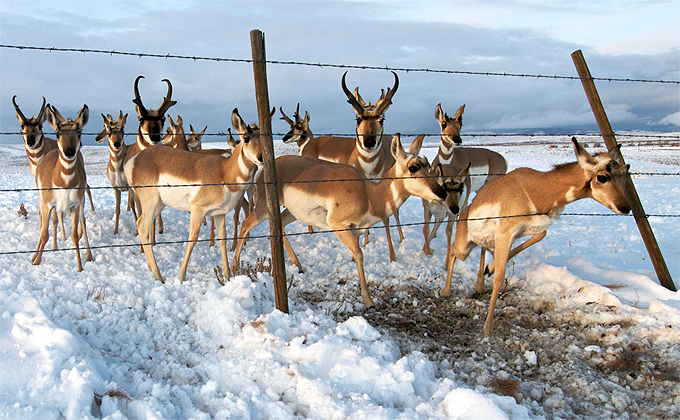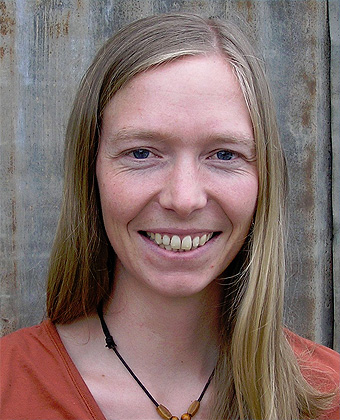
The Bill Lane Center for the American West, Stanford University

Knight-Risser Prize Winner Spent Two Years
On the Trail of Migrating Pronghorn
By Robin Evans
John. S. Knight Journalism Fellowships
Alone in the wilds of Wyoming, she fell trying to cross a creek and almost lost her backpack. That shook her up. She lay awake nights in her tent after a hunter told her how many grizzlies he’d seen. Yes, she was nervous, and sometimes frightened.
 But Emilene Ostlind never gave up on her quest. Over the course of two years – two spring and winter seasons – she searched for the trail of the pronghorn antelope. It’s one of many long-distance animal migrations around the world that’s increasingly impeded by human development.
But Emilene Ostlind never gave up on her quest. Over the course of two years – two spring and winter seasons – she searched for the trail of the pronghorn antelope. It’s one of many long-distance animal migrations around the world that’s increasingly impeded by human development.
“One thing that kept me going was the adventure of it. I just loved being out in those mountains during migration season – there’s not a lot of other human activity. It was beautiful, thrilling,” she said.
And each of her four weeklong forays into the wilderness brought new clues to the location of “The Path of the Pronghorn.” A graduate student in creative writing at the University of Wyoming and a fan of nonfiction writing about wildlife, she envisioned walking with a group of pronghorn and seeing the migration through their eyes.
“It didn’t work out that way at all. They walked a lot faster and are pretty skittish of humans. So it did take several migration seasons,” she said. “One thing driving me was that I had this sense early on that if I could be in the right place at the right time I would see the heart of migration. And watching that would reveal to me the importance of that migration of the species.”
The tale of that search, undertaken by her and wildlife photographer Joe Riis, was the heart of a package of stories – published in the Dec. 26, 2011, issue of High Country News – that won the 2012 Knight-Risser Prize for Western Environmental Journalism.
Anticapra Americana is the sole-surviving representative of a taxonomic family of antelope-like creatures that populated North America for over 18 million years. In Wyoming, some 300 to 400 pronghorn journey each winter and summer between Grand Teton and the Upper Green Valley to avoid deep snow, find food and familar birthing locales.
They follow a specific route. And that 120-mile corridor now includes highway crossings, gas drilling projects, residential subdivisions and a 9,100-foot mountain pass. In 2008, 45 miles of their path – that through U.S. Forest Service land – was put under federal protection.
Although she was alone, Ostlind communicated constantly with Riis as they searched for the pronghorn path. She’d point him to locations to shoot and he’d share what he found.
On her first trip out, she scouted the landscape. On her second, she spotted some hoof prints, saw several small groups of pronghorn cross the Green River and discovered the mountain pass they cross. Her third trip, the longest, was uneventful. She used a different strategy on her fourth trip – and it was rewarded. This time with her brother as company, they went early to the mountain pass– in wait for the pronghorn.
Most Wyoming residents, including her, Ostlind said, are unaware of this ancient migration and the perils it faces. “Before I started the project I knew nothing of it, though I’ve lived in Wyoming my whole life. I still meet people who are totally ignorant of it.”
Ostlind ended up getting concurrent degrees in Creative Writing and the Environment and Natural Resources. Today, she’s working in communications at
the Haub School of Environment and Natural Resources at the University of Wyoming.
But she hopes to find a way to continue writing about the environment.
“In some ways I’ve been writing about wildlife and the environment since I was a kid. But those were just stories,” she said.
She started freelancing in graduate school, in 2007. And, working for a year
in the photo department at National Geographic, she said she was inspired by people telling stories in engaging ways about environmental issues.
“Writing is the thing I’m comfortable doing. Environmentalism is the thing I care about.”
Most Wyoming residents, including her, Ostlind said, are unaware of this ancient migration and the perils it faces. “Before I started the project I knew nothing of it, though I’ve lived in Wyoming my whole life. I still meet people who are totally ignorant of it.”
Texas Tribune, ProPublica

The Desert Sun and USA Today

CPI, InsideClimate News, The Weather Channel

The Seattle Times

The Sacramento Bee

High Country News

5280 Magazine

Seattle Post-Intelligencer

What Went Wrong?
The Seattle Times

San Antonio Express-News

The Los Angeles Times

High Country News




